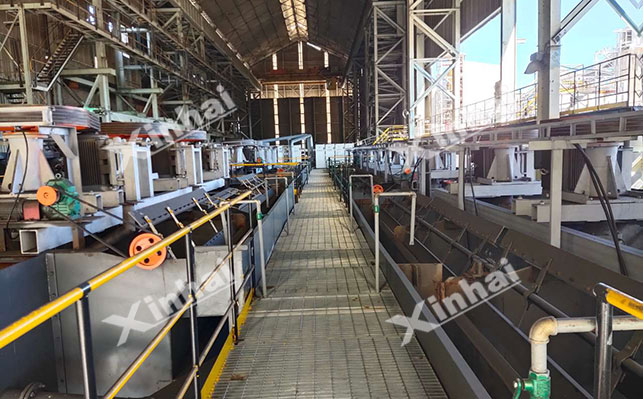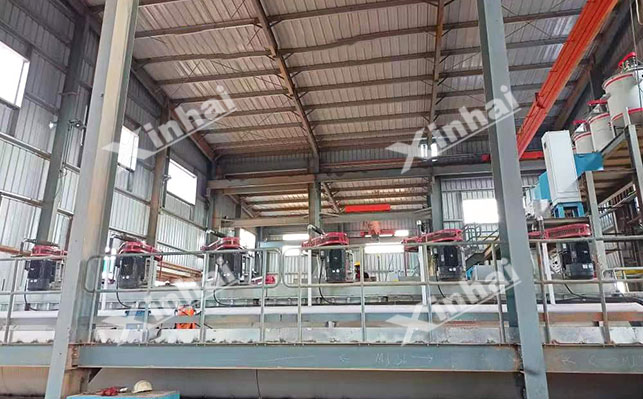
15311826613
Click to add WeChatAgainst the backdrop of the continued growth of global resource demand and the increasing awareness of environmental protection, modern beneficiation engineering is making great strides towards improving resource utilization, expanding the amount of available resources and realizing resource recycling. Traditional beneficiation processes face severe challenges due to serious resource waste and limited processing capacity for complex low-grade ores. At the same time, a series of innovative new molybdenum ore beneficiation processes continue to emerge, bringing new vitality to the beneficiation industry. The following is an introduction to several new beneficiation technologies for different types of molybdenum.
The innovative molybdenite ore dressing technology is a collector-free flotation process, which is a major innovation in traditional flotation processes. Traditional flotation processes rely on collectors to selectively adsorb target minerals to achieve mineral separation. The collector-free flotation process breaks this convention and uses the unique surface properties and floatability of molybdenite to achieve effective flotation without adding collectors. The process flow is as follows:

Grinding stage: Grind the molybdenite ore to P80=100μm. The purpose of grinding is to fully dissociate the molybdenite particles from the gangue minerals, creating conditions for subsequent flotation separation. Appropriate grinding particle size is crucial for collector-free flotation. If the grinding particle size is too coarse, the molybdenite and gangue minerals are not completely dissociated, affecting the flotation effect; if the grinding particle size is too fine, it may lead to over-crushing, increase energy consumption and production costs, and is also not conducive to subsequent flotation operations.
Roughing stage: In the ore pulp after grinding, only the frother MIB (methyl isobutyl carbinol) is added. MIB can produce a large number of stable bubbles in the ore pulp. Due to its natural floatability, molybdenite will adhere to the bubbles and float to the surface of the ore pulp with the bubbles to form a rough concentrate. After roughing, a rough concentrate containing about 11% Mo can be obtained, and the recovery rate reaches 76.8%. Although no collector is used in this stage, the initial enrichment of molybdenite is achieved by cleverly utilizing the surface characteristics of molybdenite and the role of the frother.
Regrinding and concentration stage: The coarse concentrate is regrinded to further improve the dissociation degree of molybdenite particles, and then concentrated. Through multiple concentration operations, impurities in the coarse concentrate are gradually removed, and finally a lubricant-grade molybdenum disulfide product is obtained.
Talc is a mineral with good lubricity and flaky structure. In the flotation of copper-molybdenum ore, talc is easy to float together with copper-molybdenum minerals, interfering with the flotation process and reducing the flotation index. In response to this problem, a new flotation process was developed. First, copper and molybdenum were mixed for flotation to obtain coarse concentrate, and then lime was used to inhibit pyrite and CMC to inhibit talc to obtain molybdenum concentrate. This new molybdenum ore flotation process overcomes the adverse effects of talc through targeted process design and reagent selection. The process flow is as follows:

Grinding process: Grind the ore to P80=150μm. This particle size setting comprehensively considers the dissociation characteristics of copper-molybdenum minerals and talc and the requirements of subsequent flotation processes. Appropriate particle size can ensure the effective separation of copper-molybdenum minerals and talc, while avoiding the increase in energy consumption and mineral muddling caused by over-fine grinding.
Copper-molybdenum mixed flotation stage: Use potassium amyl xanthate and diesel as collectors for copper-molybdenum mixed flotation. Potassium amyl xanthate has good collection performance for copper-molybdenum minerals, and diesel can enhance the hydrophobicity of the mineral surface and improve the flotation effect, thereby obtaining a copper-molybdenum mixed coarse concentrate.
Copper-molybdenum separation and talc inhibition stage: After the coarse concentrate is re-grinded, lime is added to inhibit pyrite and reduce the interference of pyrite on copper-molybdenum separation. Subsequently, CMC (carboxymethyl cellulose) is used to inhibit talc. CMC can selectively adsorb on the surface of talc, making its surface hydrophilic, thereby inhibiting the floating of talc.
Molybdenite flotation and CMC desorption stage: CMC is desorbed by heating to eliminate its potential impact on molybdenite, and then molybdenite flotation is carried out to further improve the grade and recovery rate of molybdenite concentrate.
The combined smelting process is mainly used to process low-grade copper-molybdenum concentrates that are difficult to select. The copper and molybdenum grades in this type of concentrate are low, and the mineral composition is complex, containing more gangue minerals and impurities. It is difficult to obtain ideal economic and technical indicators with traditional single ore dressing or smelting methods. Through the new ore dressing-smelting combined process, the advantages of both can be fully utilized to achieve effective treatment of low-grade copper-molybdenum concentrates that are difficult to select. The process flow is as follows:

Desliming and reverse flotation talc stage: The copper-molybdenum mixed concentrate is first deslimed by a hydrocyclone to remove fine-grained gangue minerals and muddy impurities, reducing their impact on subsequent flotation and smelting processes. Then reverse flotation talc is carried out, and appropriate collectors and regulators are used to make talc float out first, further improving the quality of copper-molybdenum concentrate.
Molybdenum concentrate oxidation roasting stage: The molybdenum concentrate after desliming and reverse flotation is oxidized and roasted. At high temperature, molybdenum sulfide (MoS₂) in molybdenum concentrate is oxidized to industrial molybdenum oxide (MoO₃). Molybdenum oxide is an important form of molybdenum products and can be widely used in steel, chemical and other industries.
Copper concentrate oxygen pressure oxidation stage: Copper concentrate adopts oxygen pressure oxidation process. Under the conditions of high pressure and oxygen, copper minerals are oxidized to generate soluble copper salts. Through subsequent solvent extraction and electrolysis processes, electrolytic copper products are obtained, and low-copper molybdenum concentrate is produced at the same time, and the molybdenum resources can be further recovered.
With the continuous development of molybdenum ore resources, the treatment of high-copper molybdenum concentrate has become an important issue facing the mineral processing field. When traditional processes are used to treat high-copper molybdenum concentrate, in order to achieve copper-molybdenum separation, a large amount of inhibitors such as NaHS are required, which is costly and harmful to the environment. The oxygen pressure oxidation process achieves preliminary separation of copper and molybdenum by chemical oxidation, reducing the cost of reagents and reducing the difficulty and cost of wastewater treatment. The process flow is as follows:
Oxygen pressure oxidation stage: Place the molybdenum concentrate in a high-pressure reactor and carry out oxidation reaction in the presence of oxygen. In this process, the leaching rate of copper is high, while the leaching rate of molybdenum is low. This is because under specific oxygen pressure and temperature conditions, copper minerals are more easily oxidized into soluble copper salts, while molybdenum minerals are relatively stable, and most of them still exist in solid form.
Copper enrichment and electrolysis stage: The filtrate after the reaction is subjected to a solvent extraction process, and a specific extractant is used to selectively enrich copper ions. Then, through the stripping operation, the copper ions are transferred from the extractant to the aqueous solution to obtain a copper sulfate solution. Finally, by electrolyzing the copper sulfate solution, electrolytic copper is precipitated on the cathode to achieve copper recovery.

In addition to the above-mentioned typical new processes, there are also beneficiation-Bayer process, new technology for biometallurgy of copper sulfide ore, flotation-molybdenum blue method, low-grade molybdenum concentrate-oxygen pressure oxidation method, etc., which are also effective methods for recovering molybdenum.
Ore dressing-Bayer process: This technology combines the advantages of ore dressing technology and Bayer process. When processing certain ores containing metals such as aluminum and lithium, the target minerals are first enriched by ore dressing, and then the Bayer process is used for subsequent chemical treatment. This combined process can extract metals more efficiently, improve resource utilization, and reduce production costs.
New technology for biometallurgy of copper sulfide ores: The copper element in copper sulfide ores is converted into a soluble state by the metabolism of microorganisms, thereby realizing copper extraction. This technology has the advantages of being environmentally friendly and having strong adaptability to low-grade ores. Under a suitable environment, microorganisms can oxidize the sulfur element in sulfide ores, allowing copper to enter the solution in the form of ions, and then recover copper through extraction, electrolysis and other methods. Compared with traditional pyrometallurgy, new biometallurgical technology reduces the emission of harmful gases such as sulfur dioxide, and can process complex ores that are difficult to process by traditional processes.
Flotation-molybdenum blue method: This is an innovative process for molybdenum ore dressing. Molybdenum ore is first enriched by flotation to obtain molybdenum concentrate. Then, the molybdenum concentrate is subsequently treated to convert it into molybdenum blue. In this process, the chemical property changes of molybdenum under specific conditions are utilized to achieve further purification and separation of molybdenum. This method can effectively improve the purity of molybdenum products and meet the quality requirements of molybdenum in different industrial fields.
Low-grade molybdenum concentrate-oxygen pressure oxidation method: specially used to treat low-grade molybdenum concentrate. Under the action of oxygen pressure, the molybdenum concentrate is oxidized to remove impurities in the molybdenum concentrate and improve the grade of molybdenum. This method can expand the scope of molybdenum ore resources and convert molybdenum ore resources that were originally abandoned due to low grade into products with economic value.
In the field of molybdenum ore dressing, both traditional and innovative processes have their own advantages. Traditional processes have been tested by time, with high technical maturity and strong equipment stability; while innovative processes keep pace with the development of science and technology, and have more obvious advantages in improving resource utilization, reducing energy consumption and environmental protection. However, whether it is the traditional method or the new method, only the suitable method can obtain the ideal molybdenum concentrate. Therefore, if you want to select the molybdenum ore dressing process, you need to conduct a dressing test on the molybdenum ore. Designing a suitable process plan through experimental analysis is an effective way to obtain the ideal molybdenum concentrate.